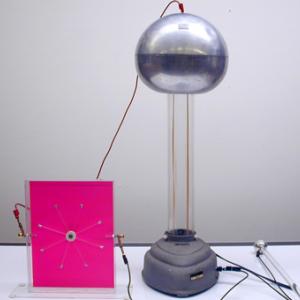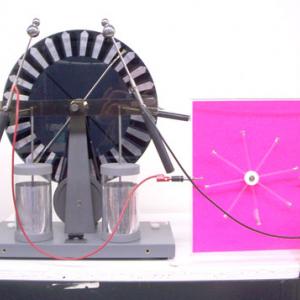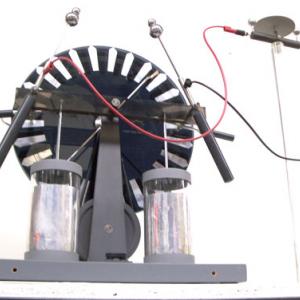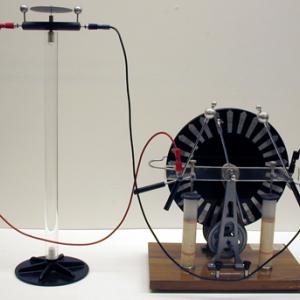College of Liberal Arts & Sciences
5A50.52 - Electrostatic Motor
Connect one pole of the motor to the base of the Van de Graff and the other pole to the dome. Turn on the Van de Graff and the motor should start to spin. If the field grows to large and the Van de Graff sparks the motor will start to slow down. To get around this use the grounding rod to limit the size of the Van de Graff field.
Instead of the Van de Graff the Whimshurst may be used for better control of the electric potential, thus giving less arcing.
- Paul Chagnon, "Animated Displays VI: Electrostatic Motors and Water Dropper", TPT, Vol. 34, # 8, Nov. 1996, p. 491.
- Oleg Jefimenko and David K. Walker, "Electrostatic Motors", TPT, Vol. 9, # 3, March 1971, p. 121.
- Guido G. Pegna, "A Simple "Electrostatic" Motor", AJP, Vol. 45, # 2, Feb. 1977, p. 218.
- Oleg Jefimenko, "Franklin's Electric Motor", AJP, Vol. 39, #10, Oct. 1971, p. 1139.
- Robert A. Morse, "Laboratory Activity 11, Building an Electrostatic Corona Discharge Motor", Teaching about Electrostatics, p. 3 - 37.
- C. L. Stong, "Electrostatic Motors Are Powered By Electric Field of the Earth", The Amateur Scientist, October, 1974.
- Rudolf F. Graf, "An Electrostatic Merry-Go-Round", Safe and Simple Electrical Experiments, p. 27.
- "Electrical Wheel", Pike's Illustrated Catalogue of Scientific & Medical Instruments, 1984, p. 287.
Disclaimer: These demonstrations are provided only for illustrative use by persons affiliated with The University of Iowa and only under the direction of a trained instructor or physicist. The University of Iowa is not responsible for demonstrations performed by those using their own equipment or who choose to use this reference material for their own purpose. The demonstrations included here are within the public domain and can be found in materials contained in libraries, bookstores, and through electronic sources. Performing all or any portion of any of these demonstrations, with or without revisions not depicted here entails inherent risks. These risks include, without limitation, bodily injury (and possibly death), including risks to health that may be temporary or permanent and that may exacerbate a pre-existing medical condition; and property loss or damage. Anyone performing any part of these demonstrations, even with revisions, knowingly and voluntarily assumes all risks associated with them.



